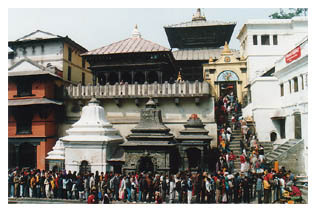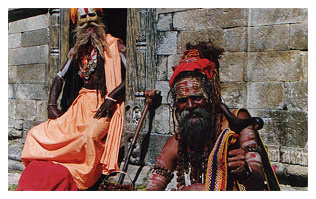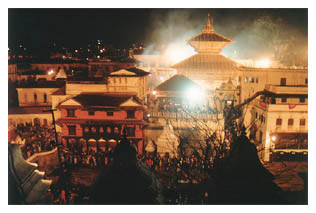|
All cows are sacred, but one with five legs must be
really sacred
Holi
Unhealthy
- Kathmandu,
Nepal
In
Nepal, there seems to be a festival every week.
Actually I am being
told that in one year there are
more than 365
festivals, but not all demand the pomp
and circumstance.
Businesses close, schools close, and
the people come out en
masse to celebrate whatever the
holiday du jour happens
to be. So far, I have
celebrated Losar, the
Tibetan New Year, Shripanchami,
the festival of
Saraswoti, the Goddess of Education,
and two recent biggies,
Shivaratri and Holi.

Shivaratri,
literally translates to 'Night of Shiva'
the most important God
in Nepal. It's his birthday, so
be sure to wish him a
happy one. In Kathmandu at the
most important Hindu
temple, Pashupati, sadhus, those
supremely elastic,
nearly naked, dred-locked Hindu
holy men/gurus flock en
masse from all over the
subcontinent. Most of
the time, they spend their days
in contemplative, ganga-induced,
religious highs, but
on this day, the weed
of choice happens to be opium,
Shiva's favorite. And
not only do the sadhus partake,
Nepalese everywhere
take up the pipe and smoke away,
singing, dancing and
drinking.

Pashupati becomes a
beacon for sadhus and they descend upon the local grounds and set up shop.
There are sadhus handing out ganga, some in meditation, some doing
unimaginable feats of death-defying gravity with their penises, some
drinking chiya and chatting, and some just sitting around posing. The
grounds around Pashupati become like a circus. Complete with neon gates
and food booths. As is tradition, free food booths are set up everywhere
and for 24 hours, you can eat all the samosas, curries, pakoras, rotis,
bhatas and churras you can for free. Devi's mom came to visit the temple
and she joined the line that took more than five hours for it to wind its
way to the gates. We sat and watched the crowds wind slowly toward its
destination. On the banks of the Bagmati, other sadhus have set up
blessing stations where you can receive prayers, an intricate gold, red
and silver tika and a string tied around your wrist. Don't forget the
donation.
Elsewhere
in Nepal, the festival is not to be
taken lightly either. Bonfires
are built everywhere, the
taller the better and
burn throughout the night, while
people celebrate around
them. But the most curious
aspect of the whole
affair happens to be the explosive
sugar canes. For a week
before, sugar canes are sold
everywhere and people
stock up on ten-meter lengths.
During the night, while
the fires burn, the sugar cane
is thrust into the fire
and left for about five
minutes. Then some
Nepali boy or man quickly pulls it
out and runs over to
the street or sidewalk and
swinging it over his
head as hard as he can, slams it
against the ground. The
cane explodes, just like you
would imagine in a
cartoon, ear-popping boom,
blackened scorched
ground and the splintered curling
end of a blown out
sugar cane. But it sure is good to
munch on afterwards,
the meat soft and sweet. All
night long, you could
hear what sounded like repeated
gunfire all over the
city. The gatherings were biggest
near the Shiva temples
and we made our way to one
small temple in the
countryside, where I got to try my
hand at exploding sugar
cane, and of course more
Nepali dancing and
singing. After midnight,
the rowdy factor increases exponentially, as
the Nepali men smoke
away at the pipe and down the
local raksi.

Pashupati on the night
of Shiva Ratri as crowds are still waiting to enter the temple grounds for
puja
The
other wholesome festival I got a taste of
(literally) is Holi, a
day that is celebrated with
more vigor, if that is
possible, than Shivaratri. Holi
represents the victory
of the great King Ram over his
enemies but the
celebration today bears little
resemblance. Holi is
known as the festival of water
and color. The eight
days preceding the actual day are
a build up of water:
water balloons, water guns, water
spray, water everywhere
and most of it aimed squarely
at the uninitiated, the
foreigner, although the
Nepalese are not immune
to it. Water balloons will
drop from five floors
up squarely on your head, water
spray will find it's
way through the window of a taxi,
plastic bags of water
will explode at your feet
walking through an open
square. And a little child
will run up to you only
to shoot you in the face with
his water gun. Beware!
Kathmandu is not the best place
to be, so of course I
went! After a few balloon bombs
(yes, I actually have
bruises) I went for revenge and
stocked up on plastic
baggies, water balloons and a
water squirter. Best to
be prepared. But I quickly
found I didn't have a
chance. It was me against them,
alot of them. I had to
laugh at the sight of a
startled drenched
Nepali women in her pretty, but now
wet sari, but mostly
everyone else was doing the
laughing at me. But
this buildup did not adequately
prepare me for the
deluge to come on the actual day of
Holi. Remember, I said,
festival of water AND color.
Well, imagine the water
has become a flood and it is
now tinted all colors
of the rainbow. Balloons were
exploding at my feet
spraying me with red, black,
yellow, green, or blue
inky water. Red waterfalls
poured over the
rooftops to drench anyone
indiscriminately.
Bright pink liquid comes out of
nowhere, the vandal
artfully hiding himself. No where,
no one to retaliate
against. But then, I made the
biggest mistake of all.
Til now, I have been hiding
out in the locals part
of town, staying with friends,
conversing with the
locals and generally avoiding the
pit known as Thamel,
the backpacker ghetto. But today,
I really needed to do a little work, so I went early enough to make
it into the cyber cafe
without any problems, but then
I made mistake number
two. Armed with my Nepali
version of the Super
Soaker, I couldn't resist hitting
a few Nepalis from the
second floor window of the
cyber cafe, but of
course, I should have known, I was
outnumbered and they
were taking names. When I exited
the cafe, not only was
I hit by my victims, roving
bands of painted Nepali
boys were on the prowl. Armed
with a wet pasty mix of
powder and water in plastic
bags, they were
scooping the color and smearing it all
over my face, hair,
shirt everywhere. In about one
minute, I was covered
head to toe, but it didn't let
up. 'Pugyo! Pugyo! JAU!'
(Enough, enough, GO!) The
color was in my mouth,
my nose, my contacts were pink
even. After that I
welcomed the water that seemed to
pour from every rooftop
in Thamel. My hair was
streaked all sorts of
colors and sticky to the point
of dred-locks. My hands
stained deep dark red, the
holiest and most
popular color. After befriending some
of them with my Nepali
and convincing them I wasn't
the usual tourist, I
joined their gang and armed with
red powder, a bottle of
water (to mix) I figured what
the hell. It was great!
Although, no doubt some of the
tourists did not like
it one bit, as the hassling
sometimes turned to
groping, most enjoyed it and I had
the most fun, trying to
hit the locals who had come to
Thamel to hunt.
All
fun and no pain never lasts. Having traveled all
last year without any
bad incidents, I finally was
struck down with
dysentery right after coming back
from Kathmandu. When
you urgently need to go to the
bathroom every ten
minutes, you don't want to be doing
it into a hole in the
ground, so I went to Pokhara to
rest and recuperate. It
was so much nicer to become
intimate with the
porcelain goddess rather than mother
earth. What was coming
out was pretty explosive. High
velocity, projectile
diarrhea. With a very high fever
to match, it was not a
pretty sight. Thankfully, my
friend Devi helped me
through it with water (lots)
fruit juice and extra
toilet paper. And I shouldn't
forget the drugs. At
the local pharmacy, he managed to
pick up some pretty
potent medication for dysentery
and diarrhea. And
finally the fever subsided, the poo
slowed and I came back
to the land of the living with
my bottle of bright
orange (but definitely not
orange-flavored) oral
rehydration salts liquid. Now I
live wary, wary of the
water, wary of the food, wary
of anything that will
ignite the war my butt started.
back
to Meet the Sapkotas
|



